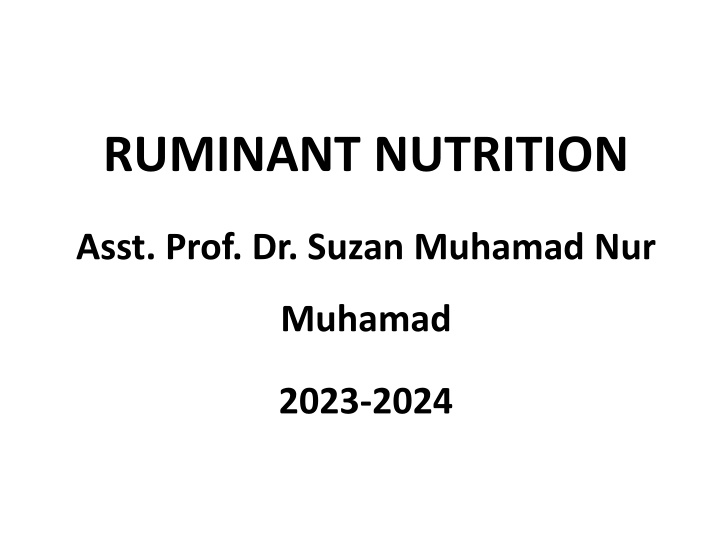
Ruminant Nutrition and Digestive Systems
Proper nutrition is crucial for the health and productivity of animals. This course delves into the complexities of ruminant nutrition, including the breakdown of feeds, digestive processes, enzymes, and the unique features of ruminant digestive systems. Learn about the importance of nutrients, digestion, and absorption in sustaining animal life and productivity.
Download Presentation

Please find below an Image/Link to download the presentation.
The content on the website is provided AS IS for your information and personal use only. It may not be sold, licensed, or shared on other websites without obtaining consent from the author. If you encounter any issues during the download, it is possible that the publisher has removed the file from their server.
You are allowed to download the files provided on this website for personal or commercial use, subject to the condition that they are used lawfully. All files are the property of their respective owners.
The content on the website is provided AS IS for your information and personal use only. It may not be sold, licensed, or shared on other websites without obtaining consent from the author.
E N D
Presentation Transcript
RUMINANT NUTRITION Asst. Prof. Dr. Suzan Muhamad Nur Muhamad 2023-2024
Course overview: Proper nutrition is essential for the health & productivity of all animals and is the basis of successful production systems. Nutrition is the science of providing nutrients to animals in adequate amounts and in forms that the animals will consume. Nutrition is the study of how the body uses the nutrients in feed to sustain life and for productive purposes. Nutrition is a very complicated science. We must study the nutrients themselves and also look at how animals consume, digest, absorb, transport, metabolize, and excrete them.
Feeds and feedstuffs are chemically complex mixtures of substances that contain the nutrients an animal needs. The digestive tract breaks down those complex materials to their constituent parts so the nutrients can be absorbed and metabolized by the body. Breakdown of food by the digestive system in preparation for absorption is called digestion (The physical, chemical, and enzymatic means the body uses to render a feedstuff ready for absorption) and is accomplished in three ways:
1- The physical or mechanical actions of chewing (mastication) and muscular action of the digestive tract (peristalsis). 2- The chemical action of hydrochloric acid(HCL), which is used by the stomach to denature proteins and bile that is used in the small intestine to help digest fats. 3- The action of enzymes, which increase the speed of the breakdown of the chemical bonds in foods by the addition of a water molecule (hydrolytic enzyme)
Enzyme (proteins capable of catalyzing reactions associated with a specific substrate) Enzymes can be produced by the digestive tract and accessory organs (liver, pancreas), or by microorganisms living in symbiosis with the animal. Enzymes are biological catalysts that speed the rate at which a particular reaction reaches equilibrium. Many enzymes are found in the system and are needed for faster and more efficient digestion.
The type of digestive system an animal has dictates what the animal can successfully use as feed. The more complicated the feed (like forage), the more complicated the digestive tract. Thus, the ruminant system is designed to retain feed for several days, which is a long time compared to the few hours that a feed is held in a carnivore's simple tract.
General concept of how to use the correct chemical analysis and benefit from Proximate Analysis of feedstuff - general guidance on how to use nutrition lab. repetition in chemical analysis, Sampling of feedstuffs for analysis and how to save samples before analysis, Determination of Moisture , Ash, Silica, Crude fat, Crude fiber, Crude Protein, and calculating the carbohydrates in food samples and making rations for farm animals. proportion of soluble
Course objective (Theory): 1- Define nutrition and understand the reasons for studying nutrition. 2- Describe the general uses of nutrients in the body. 3- Describe the methods of the breakdown of food. 4- Classify digestive systems according to stomach type of diet consumed. 5- Describe the steps of digestion. 6- Explain the importance of the complex stomach of the ruminant and its `benefits to the animal. 7- Feeding Standards for maintenance, growth, reproduction and lactation
The Topics: 1- Nutrition definitions and terms Chemical composition of plants and animals: 2- Composition of Plant and Animal, Water, Dry matter and its composition 3- Carbohydrates Classification of carbohydrates, Monosaccharide's, Disaccharides, Polysaccharides & Lignin 4-Digestion and Metabolism of Carbohydrates 5-Proteins, nucleic acids and other nitrogenous compounds. Digestion and Metabolism of Proteins 6-Lipids Classification of Lipids, Fats, glycolipids, Phospholipids, Waxes & Steroids Digestion and Metabolism of Lipids 7- Energy metabolism
8- Vitamins, Minerals Fat and water-soluble vitamins Function of minerals, Trace and Major elements 9- Classification of Digestive Systems 10- Enzymes, Digestion in mammals 11- Microbial digestion in ruminants and other herbivores 12&13- The Nutrient Requirements(energy and protein) of Animals, Feeding standards for: Maintenance, growth 14- The Nutrient Requirements (energy and protein) of animals, reproduction ,lactation. 15- Ration Formulation
Nutrition definitions and terms Nutrition involves various chemical Nutrition: reactions and physiological processes, which transform foods into body tissues and activities.
Nutrient: The chemical substances found in the feed materials are necessary for the maintenance, production and health of animals. The chief classes of nutrients include- 25 carbohydrates, 20 amino acids, 15 fatty acids, 15 essential and 10 probably essential minerals, 20 vitamins and water or any chemical compound having specific functions in the nutritive support of animal life.
Nutritionist: A specialist in the problems of nutrition. Nutrigenomics: Effects of nutrients on gene expression have been studied well in recent years. Nutrigenomics, a branch of nutritional genomics, is the study of the effects of foods and food constituents on gene expression. Nutrigenomics has also been described as the influence of genetic variation on nutrition, where gene expression or single nucleotide polymorphisms (SNPs) are correlated with a nutrient s absorption, metabolism or biological effects.
Introduction Food is material that, after ingestion by animals, is capable of being digested, absorbed and utilized. In a more general sense we use the term food to describe edible material. Ruminant comes from the word rumen which is the first major compartment in the four-compartment stomach of the cow, sheep and goat. This structure is the furnace where microbial fermentation takes place. Millions of bacteria, protozoa and fungi live in the rumen and break down energy-rich plant parts, making them digestible for the host animal.
Millions of bacteria, protozoa and fungi live in the rumen and break down energy-rich plant parts, making them digestible for the host animal. Cattle, sheep and goats have the ability to convert plant carbohydrates and proteins into available nutrients for human use.
Advantage of Ruminants 1-Are not competitive to humans. 2-Convert low nutrient density organic materials into food for humans by anaerobic microbial fermentation of fibrous plants and plant residues in the rumen. 3-Provide services and assist in recycling soil nutrients.
Disadvantages of Ruminants 1 Fermentation of high energy feeds yields to the animal than digestion in the small intestine 2 Energy losses: Heat of fermentation Loss of carbon through gas production (CO2 and CH4),end products of fermentation 3 Conversion of high quality dietary protein to microbial protein may result in decrease in biological value of the protein.
Plants and animals tissues are made up of similar type of chemical substances but their relative amounts are variable. Plants and animals are analyzed by proximate method. Plants and their by-products show much larger differences in the chemical composition than the animals.
Plants synthesize complex materials from simple substances such as carbon dioxide, water, nitrates and other mineral salts from the soil and energy trapped from the sun by the process of photosynthesis. The greater parts of the energy trapped as a chemical energy within the plant itself and the animals use this energy. Thus, plants store and animals dissipate energy.
Basis of expressing the chemical composition: The chemical composition of the feed stuffs can be expressed in three ways:- 1. On fresh basis (as such basis) 2. On dry matter basis 3. On air dry basis
A- Water Water ranks second only to oxygen in importance, water is the most important dietary essential nutrient. Loss of about 1/5thof body water is fatal. Water, which is composed of hydrogen and oxygen in the ratio of 2:1 is not only the largest single constituent of nearly all living plants or animal tissues but it also performs exceedingly important function.
It is organic macronutrient. The water content in the plant decreases with the progressive maturity. The growing plants usually have 70 to 80 % of water and seeds have at least 8-10 % of water. Water content in animal body may differ due to age and nutritional status of animal.
The animal body may contain 50 to 95 % water. In case of cattle water content is approximately 95 % for the embryo, 75 to 80 % at birth, 68 to 72 % at five month and 50 to 60 % in the mature animals. Whereas blood contains 90-92 %, muscle contains 72-78 % bones contain about 45 %and enamel of teeth which is hardest tissue of body contains 5 % water.
Functions of Water: 1. Water is an essential constituent of the animal body and foodstuff. It makes the food soft and palatable. 2. It helps in regulating body temperature. 3. It helps in absorption and transportation of nutrients to different parts of the body. 4. It is an essential constituent of almost all the juices and secretion of the body. 5. It helps in the excretion of waste product in the form of urine, faeces and respiration from the animal body.
6. It acts as a solvent of many constituents of body nutrients. All the biochemical and physiological reactions take place in liquid medium. 7. It provides shape to the body cells and essential for cell nutrition. 8. During the period of hibernation, metabolic water keeps the animal alive. 9. It helps in maintaining the acid-base balance of the body. 10. It helps in hearing by the ears and visions by the eye.
Sources of Water: 1. Drinking water: It is consumed by the animals from the outside source. 2. Feed: Moisture content of all the feeds supplies the water requirement of the animal.
3. Metabolic / Oxidation water: It is the water, which is produced due to metabolism of nutrients. It meets 100 % of water requirement in hibernating animals and embryo, 4- 10 % in domestic animals and 16-26 % in desert animals. A 100 g of each fat, carbohydrate and protein metabolism produce 107, 60 and 40 g metabolic water, respectively.
4.Bound water: The water, which is combined with the constituent of protoplasm by either physical or chemical means. It cannot separate easily from protoplasm by freezing at low temperature or by evaporation at high temperature or under dry conditions. Bound water is of special interest in connection with the ability of plants and animals to resist at low temperature and drought condition.
Water requirements of various classes and species of adult livestock Animal liter/day Animal liter/day Beef cattle 22-66 Swine 11-19 Dairy cattle 38-110 Chicken 0.2-0.4 Sheep & goats 4-15 Turkeys 0.4-0.6 Horses 30-45






















